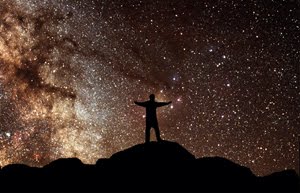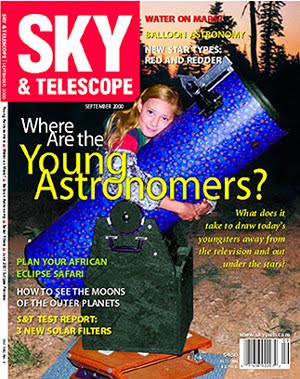What a night! I took the scope out about 7pm to cool down, while I cleaned the swamp (my pool was rather green). It had been a gorgeous day with just a few small clouds.
My daughter Mimi, 9 years old, helped my collimate the scope. She did an admirable job. The scope of the day was my 10" f/5.6 tie-dye.
As darkness started, I just peeked at star images... Alberio, Vega, Altair, Arctutus. I was fairly pleased with what I was seeing.
I went in the house and played on the computer for a while (work). As darkness filled the sky, my son, Daniel, his friend Eli and my daughter were night swimming, getting the last of their summer vacation ya-ya's out.
About 11:15 I took a peek out back. Jupiter was now clear of the trees and the stars had forgot their twinkle. The Milky Way was *obvious* overhead. It looked like a primo night in Los Gatos.
In went the 19 Panoptic. Sheeee-eeeeee-man-eeeeeeee! Look at the detail. Oh well, low power.. only 107X. But still. That baby was a rock! In went the 10mm Meade. Holy cow... look at the moons! Io and Europa were off on the trailing limb, looking like two small beady eyes. The looked like they might touch. Far off the leading egde sat Callisto and Ganymede. As many of you know, I am not much of a planetary observer, but the view of those two moons, compared to the other pair, was amazing. They were resolved as very definate discs. In fact, all four moons did. But C and G were "big" discs comparatively. G looked yellowish, G somewhat paler, maybe a bit rusty. They were set much wider apart than the smaller close pair.
Well, Jupiter put on a kingly performance. In went the 7.5mm Orion Ultrascopic (190X).... really a decent ocular for the target. There were moments of such clarity, I found myself not breathing. It was astro-apnea. Almost dead on the meridian of the Northern Equatorial Belt, a sight I'd never seen before. Geesh, I hope this is right, becuase I swear I saw it, as did my wife, sister-in-law and Mimi.
There sat, two shadows. Io and Eurpoa's dark twins. One was in the NEB, at the northern edge, the other just below it, off the NEB in the equatorial zone. Toward the trailing edge, just next to the shadow in the NEB, was a large white oval. In moments of extreme clarity there were many white spots in the equatorial zone just inside the NEB. Shooting up from the NEB into the equatorial zone just off the meridian toward the trailing edge was what I assume to be a very large festoon, like a diagonal slash pointing back toward the trailing limb.
Observing the planet for 45 minutes, the positions of Io and Europa makedly changed. They were dancing together around their magnificient host. Now, they lay diagonal to eachother relative to Jupiter. Their shadows pushed further toward the leading edge.
My wife and sister-in-law would gasp during moments of extreme still and transparency. It was transfixing.
Looking up, left of the large oak in my neighbors yard, I noticed the Great Square of Pegasus up high. Saturn? :-) Just in position. Where in the yard could I haul the scope? Well, I found that I had just enough room to place the scope between the redwood deck and pool. I could balance on the coping... hovering above the deep end. Saturn was amazing. My wife looked and marveled at the view, but my sister-in-law was concerned about the precarious location. Further back into the yard we went, onto the grass. There, we set up and viewed Saturn for about 15 minute. Cassini's division was like a black marker 3/4ths out toward the edge of the rings. Across the souther face of the planet's disc was a large darker band. The inner edge of the rings cut a black line across the face of the planet. Moons were sprinkled here and there. While I enjoyed Saturn, and the beauty of her rings and the clarity of the view, I knew, with no doubt, Jupiter was king.
The scope was airborne again, hovering over the swimming pool as I heauled it back to the Jupiter side of my backyard. Again, there were moments of clarity that I have not seen in over a year. Supreme detail. I am not sure of this either, but unless I am mistaken, on the upper (southern) equatorail belt, just appearing from the trailing edge, was the Great Red Spot (well, maybe it should now be called the Great Slightly Darker Spot). All the detail was there in the best moments. White ovals, festoons, double shadows transit, anywhere from 6 to maybe a dozen belts (or, maybe 8, depending on what is considered a belt and what is not), the GRS, two pair of moons flanking the giant planet, two of the moons almost touching while moving.
It was a great night. When conditions are just right, deep sky observing can't hold a candle to the king and queen of our solar neighborhood. It is rare that so many wonderful sights can be enjoyed in one evening. I was very lucky.











